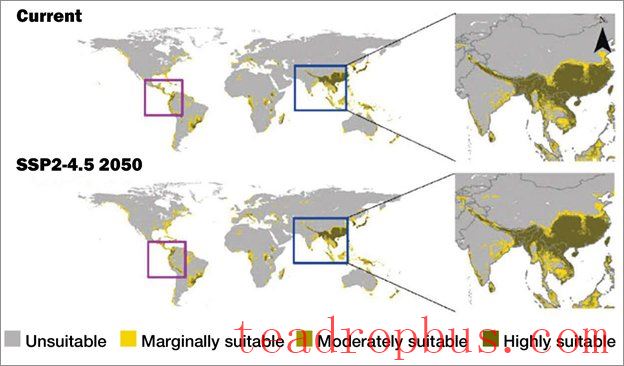
New study warns that by 2050, the world’s top tea-producing countries could see significant declines in the amount of land suitable for tea cultivation. Photo credit: Science Direct
A landmark international study published in Environmental and Sustainability Indicators (May 2025) issues a stark warning: climate change will significantly redraw the contours of the global tea industry by mid-century. The research utilizes cutting-edge climate modeling and high-resolution suitability mapping to present one of the most detailed forecasts to date, conducted by scientists from Assam University in India, the University of Wisconsin, and Addis Ababa University.
Under both moderate and high-emission scenarios, the study outlines how traditional tea-growing zones will shift, shrink, or, in some cases, expand as global temperatures rise and weather patterns change.
By 2050, more than half of the world’s top 20 tea-producing countries are projected to see notable declines in the availability of land highly suitable for tea cultivation. Kenya, one of the leading exporters of black tea, could lose up to 26.2% of its optimal tea-growing zones, with average suitability dropping by as much as 39%. Future projections omit regions such as Mount Elgon and Mbeere, signaling alarming contractions in key tea belts.
In India, the picture is more nuanced. Some models forecast a slight decline of just over 2% in highly suitable areas, while others point to gains, particularly in higher altitudes, suggesting potential upslope shifts.
Sri Lanka, another major player, may see a 14% drop in optimal areas by 2050, worsening to nearly 30% by 2070. Even China is not immune, with projections showing a 4.7% reduction in its top-tier tea-growing zones, which could intensify under more severe climate scenarios.
These findings underline a growing vulnerability in the world’s established tea heartlands, raising urgent questions about the long-term sustainability of smallholder-dependent supply chains. The potential loss of prime land could directly affect farmer incomes, crop quality, and global tea availability — challenges that demand proactive adaptation strategies.
However, the shifting climate also presents new opportunities. Some countries are expected to benefit from altered growing conditions. Turkey, for instance, could see a dramatic 127-130% increase in moderately suitable tea-growing land by 2050, particularly in elevated, cooler regions. Other countries such as Iran, Rwanda, and Thailand are projected to gain between 11% and 27% in highly suitable tea cultivation zones, potentially emerging as new tea-producing hubs. These areas offer investment possibilities, though they will require significant infrastructure development, policy support, and technical capacity building to fully realize their potential.
What sets this study apart is its innovative methodology. The researchers achieved a high predictive accuracy by combining five modeling approaches — Random Forest, MaxEnt, SVM, CART, and GLM — into a single ensemble (average AUC: 0.98). The use of high-resolution global suitability maps at a 4.5 km scale offers actionable detail for decision-makers. Importantly, the models integrate not just climate data but also soil parameters such as pH, organic carbon, and available nitrogen, capturing the complex environmental matrix essential for tea cultivation. Adopting the latest CMIP6 climate projections and Shared Socioeconomic Pathways (SSPs), which are aligned with IPCC standards, ensures relevance for academic and policy use.
The study identifies six environmental factors as most influential in determining tea suitability under future climate conditions: precipitation during the warmest quarter, mean temperature of the driest quarter, soil pH at 100-200 cm depth, isothermality (a measure of temperature variability), mean temperature of the wettest quarter, and mean diurnal temperature range. When altered, these variables can significantly impact the growth, quality, and flavor profile of tea, a crop highly sensitive to microclimatic variations.
For a global tea industry in which over 60% of production comes from smallholder farmers, these projected shifts pose an existential challenge. The researchers stress the urgency of adaptation: investment in infrastructure such as irrigation and transport in emerging regions, development of climate-resilient cultivars, promotion of agroforestry and soil conservation practices, and the use of robust, data-driven planning tools to guide zoning and land-use decisions.
As the climate crisis accelerates, the future of tea will depend on how quickly and effectively the industry, across continents and supply chains, can respond. Without immediate, coordinated efforts, some of the world’s most iconic tea landscapes may become unsuitable for cultivation within a generation.